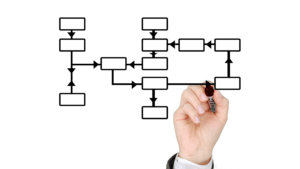
We are all experiencing disruption on a pretty regular basis lately. At some point, I suspect disruption will be so normalized that the word will lose it’s meaning, and it will just be life.
Yet there have always been disruptions. Things that didn’t go according to plan. The unexpected occurrences. Not always in big, world event kind of ways, but in the happenings of every day lives and careers.
While it may be unrealistic to think we can predict and anticipate all change, some we can.
I do not have a crystal ball, though I’ve often been accused of it. There’s no magic. Instead, I look for patterns in people, projects, and organizations. I try to “see” what’s around the corner.
When there is something that hints of what has come before, I anticipate how it may play out. Determine what I might be able to do to change the trajectory. To affect a positive outcome, or – more often – limit a negative one.
The Pre-mortem
In a recent self-leadership training I attended, the instructor shared the concept of a “pre-mortem.” There was finally a more legitimate word than “crystal ball” for the process of pattern identification and evaluation.
Most of us are familiar with a “post-mortem.” It is when we evaluate a project, event, or outcome after the fact, and then determine what we might do differently next time.
The “pre-mortem,” on the other hand, is anticipatory. It’s looking ahead at potential change, and determining what we might be able to do either prevent it or minimize a negative outcome.
The speaker shared two questions we can ask ourselves if we think change is around the corner, such as a reorganization (something I’m going through now).
- What is the worst that can happen?
- What actions can I put into place to prevent or offset that outcome?
This is something I do regularly when there are new leaders in an organization, for example, to determine what that might mean for me and my team. Other triggers include market changes or new policies that might point to tighter budgets or shifts in hiring practices.
While this was good confirmation of existing practices, I believe we can go a step further.
Taking the good with the bad
This idea of anticipating something negative so we can avoid it is relatively common. In many coaching and mentoring conversations, we leverage the pre-mortem to put language around the anxiety of the unknown. To consider what’s coming and what could happen.
I found myself doing this a lot in the months leading up to a reorganization that was six months in the making.
Following the COVID crash (burnout) I experienced last summer, I began talking with a cognitive behavioral therapist. I had become very interested in brain science, and wanted to work on retraining my brain to avoid a repeat.
As more information started to become available about the reorganization, she and I talked about what that might mean for me. This is what I do, so I already had a laundry list of possibilities, worst-case scenarios, and things I was doing to offset them.
Then she threw me for a loop. She asked something I hadn’t considered.
“What good could come out of this? What do you want to happen?”
Wow. I had been so focused on avoiding the bad, it never occurred to me to think about the good.
I realized, as a classically trained Project Manager, that we often think about risk and post-mortems from a negative context. How can we avoid, prevent, or otherwise adjust for the bad stuff?
But we are trained to also look for good risks and positive outcomes, to see what we can do to encourage those. It’s just often overlooked because our fear of the bad outweighs our pursuit of the good.
But is that what we want, or just what we’ve conditioned ourselves for?
Flipping the script
In a recent coaching conversation, I was talking with a woman about a career opportunity. It sounded amazing, and aligned to her strengths and aspirations.
Yet she hesitated. When I asked why, she had a lot of “what if’s” and anxiety holding her back.
So we walked through my original “crystal ball” question.
I asked “What’s the worst that could happen?” and she listed them out. All the fears and worries that were collecting in her mind.
For each one, we talked through how likely they were and what she might be able to do to prevent or mitigate them. Clear actions she could take, so that if she took the opportunity, she could go in more confident of a successful outcome.
Then I flipped the script. I told her about the conversation with my therapist on the positives. I followed that up with the new question.
“What would be a good outcome for you?”
We talked through positive outcomes she would like to see. For each one, we talked through how she might encourage it, or build it into her role. Even if they didn’t happen day one, by having them in mind, they were more likely to happen with intention than by accident.
Disruption can bring opportunity
Not all disruption is bad, just as not all risk is negative. There are opportunities in change.
Yes, sometimes change can bring about something we don’t want, like losing our job. Yet if we look ahead and anticipate it, we could get ahead of the job hunt. If we consider what a good outcome might be, maybe it’s a chance to make a career shift. One we wouldn’t make if we just kept going on our current path.
I have a new leader and am not sure what my future will bring. When we met, I had clear goals on what I wanted to her to know. They included my passion – what gives me energy for the work I do – and the kind of environment that allows me to bring my full self to work.
No matter what my role is going forward, I’ve considered what would be a good outcome and what matters most to me. She now knows, and will hopefully integrate my interests as she makes decisions. I’ve at least done my part to make sure they are considered.
When we find ourselves on the brink of change, the one thing we can always control is our thinking. Thoughts have power. Focusing on what we are moving towards, vs moving away from, makes us more likely to attract a positive outcome.
Our power during disruption is being clear on what we want and what good looks like. That can allow us to move forward with purpose towards the future we want.








